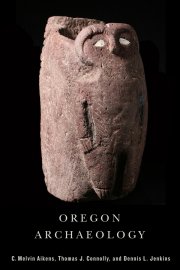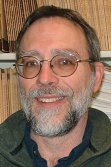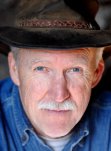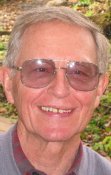 EUGENE, Ore. — (Oct. 6, 2011) — The newly revised "Oregon Archaeology" is more than just a third revision of an old book, it is a history of the peopling of Oregon from more than 14,500 years ago through modern times.
EUGENE, Ore. — (Oct. 6, 2011) — The newly revised "Oregon Archaeology" is more than just a third revision of an old book, it is a history of the peopling of Oregon from more than 14,500 years ago through modern times.
With the expanding focus, the three authors from the University of Oregon's Museum of Natural and Cultural History also changed the book's title, which had been "Archaeology of Oregon." Although the geographic organization is the same, each chapter has been entirely rewritten, says Thomas J. Connolly, director of the museum's research division.
"This book started as effort to simply update the 'Archaeology of Oregon' book with new information that had become available in the last 15-plus years," he said. "As we got into it, it became clear to us that this would be a different book. Our goal was for each chapter to tell the story of the human experience in Oregon, from earliest times to the present."
 |
 |
 |
| Thomas Connolly | Dennis Jenkins | C. Melvin Aikens |
Among the new material presented in the 512-page book, published by the Oregon State University Press, is the discovery of human DNA in 14,500-year-old coprolites — found along with the bones of extinct Pleistocene camel and horses — in the Paisley Caves near Summer Lake. UO scientist Dennis L. Jenkins, who led the excavations, is a co-author.
The third co-author is C. Melvin Aikens, a former museum director and professor emeritus of anthropology. Aikens retired in 2005 after 37 years with the UO, during which his studies focused on the archaeology of the Great Basin of North America.
"Oregon Archaeology" — written for a general audience — is divided into regions: Northern Great Basin, Columbia Plateau, Lower Columbia and Oregon Coast, Willamette Valley, and Southwestern Mountains and Valleys. These divisions represent portions of broader geographies that span much of western North America and reflect both Oregon's Native American cultural diversity and its far-reaching cultural ties.
"There were six distinct language families in aboriginal Oregon, with no discernable relationship to one another, as well as dozens of distinct languages and dialects." Connolly said. "Thus, there is not a single story to tell. We compressed the history into historical narratives."
The authors provide a rich history that embraces each region's geology, archaeology, climates and human and cultural histories. Covered in each chapter are discussions on the human communities in each region. The material is culled from research that is referenced in 58 pages of citations.
In the chapter on the Northern Great Basin, readers will learn, for example, about the arctic tundra vegetation that existed about 12,000 years ago and how the region progressed through a lengthy period of drought before experiencing a rebirth of lakes 5,600 years ago when global cooling brought glacial advances into the Cascades. The focus then narrows to cover specific time periods.
The Columbia Plateau covers the colossal Missoula floods, which was estimated to have exceeded 10 times the combined flows of all the planet's rivers today. The chapter follows cultural developments from the site of one of North America’s earliest documented houses, a 9,500-year-old structure near the Newberry Volcano, to the many populous villages that bordered the Columbia River at the time of the Lewis and Clark expedition.
In the chapter on the Lower Columbia and Oregon Coast, the authors trace the culture of the region and address how the coast might have been inhabited. Did early natives migrate across the "Beringia" land bridge, long since submerged below the Bering Sea and a view supported long ago by the UO's Luther Cressman, or might they have arrived by boat, following kelp supplies as theorized by current museum director Jon Erlandson?
In the Willamette Valley chapter, readers enter the little documented cultural history of the Kalapuya, who spoke three languages with 13 dialects. Detailed, with photos, is the discovery of camas ovens used by natives between 3,000 and 7,500 years ago, and evidence for settled communities during the last 3,000 years that counters the nomadic characterizations of the valley's natives. The staggering impact of disease brought by Europeans is documented in a graphic in this chapter and explored in more detail in the book's final chapter.
Finally, readers will learn that the rugged topography found in the southwestern mountains and valleys made for remoteness and isolation of numerous native populations. Noteworthy in this region are the many archaeological sites found buried deeply beneath ash from the volcanic eruption 7,600 years ago of Mt. Mazama (now Crater Lake).
"Working with tribal leaders and tribal members has produced rewarding professional collaborations and enduring friendships," Connolly said. "But these relationships also enrich the scientific endeavor that is archaeology, making it always personal, and reminding us that our work is ultimately about people, families and communities with ties to the land that are ancient and passionate."
About the University of Oregon
The UO is among 108 institutions chosen from 4,633 U.S. universities for top-tier "Very High Research Activity" in the 2010 Carnegie Classification of Institutions of Higher Education. The UO also is one of two Pacific Northwest members of the Association of American Universities.
Media Contact: Jim Barlow, director of science and research communications, 541-346-3481, jebarlow@uoregon.edu
Sources: Thomas Connolly, director of archaeological research, UO Museum of Natural and Cultural History, 541-346-3031, connolly@uoregon.edu ; C. Melvin Aikens, professor emeritus of anthropology and director emeritus of the Museum of Natural and Cultural History, 541-346-5115, maikens@uoregon.edu ; and Dennis Jenkins, senior research archaeologist, Museum of Natural and Cultural History, 541-346-3026, djenkins@uoregon.edu